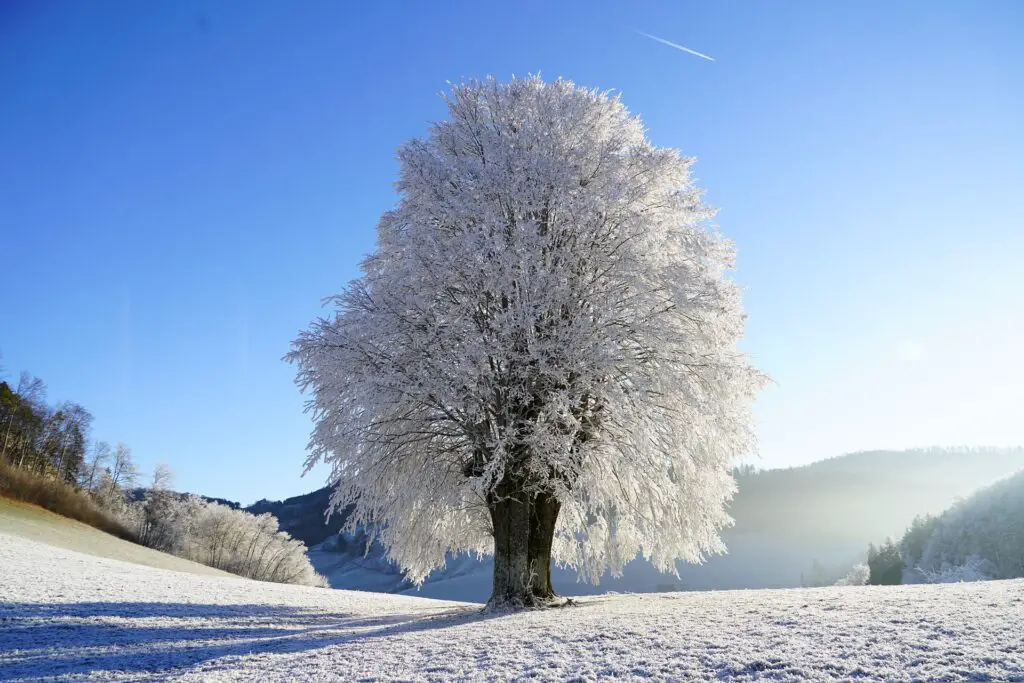Here in the mid-Atlantic region, we can count on at least one whopper of a snow or ice storm each year. I get just as excited as the kids the night before the storm. More often than fluffy, soft snow, we get a combination of freezing rain and sleet. Once this precipitation starts to accumulate, and the winds pick up, the creaking sounds coming out of the wooded area behind our house can be spooky. Accumulated ice following a storm can increase the weight of a tree’s branches by 30 times. If you’ve ever had a large branch fall on your home, car, or fence (as many of my neighbors have), ice resistance is something you’ll think about the next time that you plant a tree.
Do Some Trees Tolerate Ice Better Than Others?
Some trees are more susceptible to broken limbs during ice storms, although there are many factors to consider besides the species of the tree, as I’ll discuss below.

According to the University of New Hampshire Cooperative Extension, species of trees with the best resistance to ice accumulation in the north and mid-Atlantic region are:
- American Sweetgum
- Eastern Hemlock
- Silver Linden
- Kentucky Coffee Tree
- Littleleaf Linden
- Black Walnut
- Ginkgo
- Ironwood
- Blue Beech
- Catalpa
- Norway Maple
- White Oak
How Can You Determine A Tree’s Ice Resistance?
One of the reasons for this resilience is the shape of the tree and its branches. An important term to understand this concept is the “crown” of the tree, or the top of the tree. The crown includes the part of the tree where branches extend outward. In trees with broader crowns, there is a larger area for ice to accumulate, and the weight and strain on the tree are greater. Some examples of trees with a shape that makes them more susceptible to ice damage are Cherries, Sycamores, and Silver Maples. The shape of these trees provides an excellent shade canopy for your home. However, in climates that are prone to ice storms, the shade benefits should be weighed against the safety concerns of branches falling during ice storms.
Trees with a narrow crown and pyramid, conical, or columnar shapes don’t possess as much surface area at the top to collect ice. This makes trees like evergreens a strong choice for planting closer to your home.
Another factor is the strength of the branch junctions. This is far more important than the actual strength of the wood within the branches. In the area where I live, Bradford Pears are notorious for losing branches for this reason. Branches that grow vertically, as opposed to those oriented horizontally, are more likely to incur damage.
Another way to assess the strength of the branch junctions is to look at the bark at the junctions. If bark is “ingrown” here (has a rippled look, similar to a seam), this is a weak junction.
Can You Prevent Ice Damage by Pruning?
The best way to protect your property from ice storm damage from trees is to prune dead or decayed branches before winter, as these are less likely to withstand the added weight of ice. Pruning can also relieve substantial weight from the limbs and reduce the load from weakened areas. The structural state of your trees may not always be obvious from the ground. For this reason, it’s important to prune trees somewhat regularly, particularly if they are located close to your home.
Most trees on private property should receive a thorough pruning once every three years, with minor spot pruning each year. This will not only reduce the risk of fallen limbs during an ice storm, but will also improve the tree’s overall health. It is easiest to prune trees in early spring before all of the tree’s new leaves have appeared. This will make it easier to spot decay or cracks in the limbs. It will also allow the tree to make a faster recovery from the pruning, as its growth accelerates in spring.
The method of pruning matters, and this includes tools, cutting techniques, and pruning for the future health of the tree. A bad pruning job can result in branches that become compromised in the future with weak attachments or pest problems. When in doubt, find a certified arborist through the International Society of Arboriculture or your state’s Department of Forestry. They can assess any structural defects in your trees and may be able to prune them in a manner that can mitigate them and keep your property safer during an ice storm.
When planting a new or young tree, consider the ultimate shape, width, and height of the tree in proximity to your home, driveway, and utility lines. If you are planting trees that are susceptible to ice breakage, do so in locations where fallen limbs will do the least amount of damage to your property.
What Actions Should You Take for Ice and Snow Damage?
Trees are robust. They will often rebound from storm damage with proper pruning and patience. Prune the branches that are broken, but try to leave as many branches as possible to give the tree the best chance for survival.
When dealing with ice and snow damaged trees, it’s important to consider safety above all else. Do not attempt to clean up or remove fallen branches tangled in power lines. Use a broom to shake as much snow as possible off the fallen branches before you attempt to lift it, and do not attempt to pull branches out from heavy accumulations of snow. Use extreme caution when removing branches that are hung or still attached to the tree.
As a general guideline, Virginia Cooperative Extension reports that if more than half of a tree’s branches are damaged, the tree is not likely to recover and should be removed when it’s safe to do so. The agency also recommends hiring a professional tree removal service for bent trees and branches that are larger than six inches in diameter.
